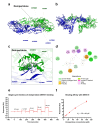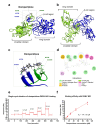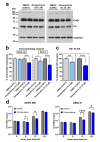Domperidone inhibits dengue virus infection by targeting the viral envelope protein and nonstructural protein 1
- PMID: 39885306
- PMCID: PMC11782576
- DOI: 10.1038/s41598-025-87146-w
Domperidone inhibits dengue virus infection by targeting the viral envelope protein and nonstructural protein 1
Abstract
Dengue is a mosquito-borne disease caused by dengue virus (DENV) infection, which remains a major public health concern worldwide owing to the lack of specific treatments or antiviral drugs available. This study investigated the potential repurposing of domperidone, an antiemetic and gastrokinetic agent, to control DENV infection. Domperidone was identified by pharmacophore-based virtual screening as a small molecule that can bind to both the viral envelope (E) and the nonstructural protein 1 (NS1) of DENV. Molecular dynamics (MD) simulations and surface plasmon resonance (SPR) analysis were subsequently performed to determine specific interactions of domperidone with the DENV E and NS1 proteins and their binding affinity. Treatment of immortalized human hepatocyte-like cells (imHC) with domperidone could inhibit DENV production and NS1 secretion in a dose-dependent manner following infection with DENV serotype 2. These inhibitory effects were mediated by reduction in viral RNA replication and viral E and NS1 protein expression, but not by interference with virus entry into cells or NS1 oligomerization. The suppression of DENV production and NS1 secretion by domperidone was observed across all four DENV serotypes to varying degrees between different virus strains. The findings from our study suggest viral target-based repurposing of domperidone for modulating DENV.
Keywords: DENV production; Dengue virus; Domperidone; E and NS1 proteins; MD simulation; NS1 secretion.
© 2025. The Author(s).
Conflict of interest statement
Declarations. Competing interests: The authors declare no competing interests.
Figures






Similar articles
-
Kinesin light chain 1 interacts with NS1 and is a susceptibility factor for dengue virus infection in mosquito cells.J Gen Virol. 2025 Jul;106(7):002132. doi: 10.1099/jgv.0.002132. J Gen Virol. 2025. PMID: 40668623 Free PMC article.
-
Dengue virus NS1 leads to downregulation of HNF4 alpha in liver cells resulting in a decrease in coagulation factors I, V, X, and XIII, contributing to coagulopathy.J Virol. 2024 Dec 17;98(12):e0141824. doi: 10.1128/jvi.01418-24. Epub 2024 Nov 8. J Virol. 2024. PMID: 39513713 Free PMC article.
-
Identification of Rhododendron mariae extraction as a new attachment inhibitor against dengue virus by targeting the envelope protein domain III.Front Immunol. 2025 Aug 13;16:1663878. doi: 10.3389/fimmu.2025.1663878. eCollection 2025. Front Immunol. 2025. PMID: 40881704 Free PMC article.
-
Pharmacophoric characteristics of dengue virus NS2B/NS3pro inhibitors: a systematic review of the most promising compounds.Arch Virol. 2018 Mar;163(3):575-586. doi: 10.1007/s00705-017-3641-5. Epub 2017 Nov 16. Arch Virol. 2018. PMID: 29147793
-
Meta-Analysis of Dengue Severity during Infection by Different Dengue Virus Serotypes in Primary and Secondary Infections.PLoS One. 2016 May 23;11(5):e0154760. doi: 10.1371/journal.pone.0154760. eCollection 2016. PLoS One. 2016. PMID: 27213782 Free PMC article.
References
-
- Kyle, J. L. & Harris, E. Global spread and persistence of dengue. Annu. Rev. Microbiol.62, 71–92. 10.1146/annurev.micro.62.081307.163005 (2008). - PubMed
-
- Guzman, M. G., Gubler, D. J., Izquierdo, A., Martinez, E. & Halstead, S. B. Dengue infection. Nat. Rev. Dis. Primers. 2, 16055. 10.1038/nrdp.2016.55 (2016). - PubMed
Publication types
MeSH terms
Substances
Grants and funding
LinkOut - more resources
Full Text Sources
Medical
Research Materials

